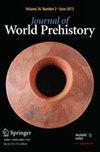来源期刊
期刊介绍:
Aims and scopeJournal of World Prehistory is an international forum for the publication of peer-reviewed, original treatments of the prehistory of an area or larger region. It was founded nearly thirty years ago with the remit of providing researchers, instructors and students with timely and authoritative research syntheses from all fields of archaeology. Journal of World Prehistory continues to lead in this field. Our classic articles may be 20,000 or 25,000 words long, as appropriate (excluding their extensive bibliographies). Since 2008 they have been joined by shorter (around 10,000 words), position pieces, which provide in-depth, thoughtful development of data and concepts, including interventions in controversies that unfold in our pages. These, written in a fashion interesting and accessible to all archaeologists, are often paired with a longer treatment in a single volume. In addition, readers now benefit from thematic special issues and double issues, in which a number of leading authors deal with a key theme in world prehistory, such as the origins of metallurgy (2009, volumes 22: 3 and 4), or the East Asian Neolithic (2013, in preparation). All papers are available first online, followed by the print edition. We aim to be truly global in coverage, with recent articles dealing, inter alia, with Amazonian lithics, the late Jomon of Hokkaido, the Bronze Age in Southeast Asia, the Neanderthal settlement of Doggerland, Neolithic networks in Western Asia, younger Dryas Paleo-Indian adaptations, and state formation in the Horn of Africa. Articles benefit from multi-language abstracts where appropriate, and we work closely with authors who do not have English as a first language to present major syntheses in a clear and concise way to an international audience. Traditionally, JWP focuses on earlier periods, but it includes the beginnings and early development of complex societies, and our understanding of ‘prehistory’ is broad and inclusive: for guidance on chronological scope, as well as our calendrical conventions, see the editorial article ‘Prehistory vs. Archaeology: terms of Engagement’ http://www.springerlink.com/content/346142p032604447/ Our unique remit means that we do not encourage the submission of unsolicited papers; rather, specific proposals are encouraged and then guided prior to independent peer review. Our aims and the way we fulfil them, with close contact with authors throughout the publication process, mean that JWP is not a venue for the simple and rapid dissemination of new results. Whilst we expect scholarship to be current, with syntheses including much new data, our readers look to us for definitive area/period coverage that will have continuing value.If you are proposing an article or special theme for Journal of World Prehistory, please read the Instructions for authors.Rated ''A'' in the European Reference Index for the Humanities (ERIH)?Journal of World Prehistory is rated ''A'' in the ERIH, a new reference index that aims to help evenly access the scientific quality of Humanities research output. For more information visit http://www.esf.org/research-areas/humanities/activities/research-infrastructures.htmlRated ''A'' in the Australian Research Council Humanities and Creative Arts Journal List. For more information, visit: http://www.arc.gov.au/era/journal_list_dev.htm
期刊最新文献
Ivories in the Late Chalcolithic Period and Their Significance for Understanding Contacts Between Egypt and the Southern Levant
Circulation of Goods and Information in Southern Patagonia During the Late Holocene: An Integrated Analysis of Engravings and Black Obsidian Artefacts
Salt Mining and Salt Miners at Talkherud–Douzlākh, Northwestern Iran: From Landscape to Resource-Scape
Prehistory to History: A New Archaeological Approach to Knowledge Transmission and the Inception of Literacy in Central Europe
Patrilocality at the Beginning of Farming? An Isotopic Approach from SE Moravia


